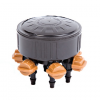Greenman68
Member
I did my halo like this. It's definitely not ideal but it's effective. I put drippers on the bottom of the tube so it jets water into the medium. I used clear vinyl tube because it's soft and easy to fit attachments to, but something blacked out would def be better to avoid algae buildup.

When there is salt buildup on the top I get the 1/4 hose with valve out and hand water a bit.


When there is salt buildup on the top I get the 1/4 hose with valve out and hand water a bit.









